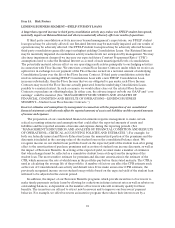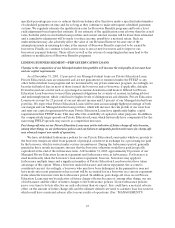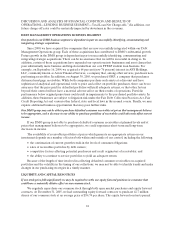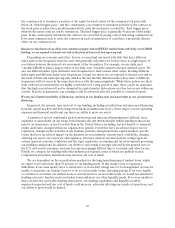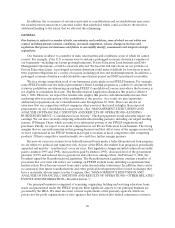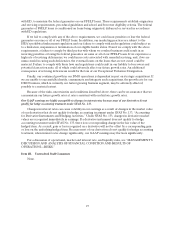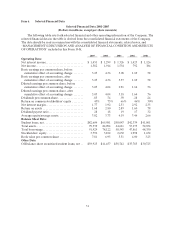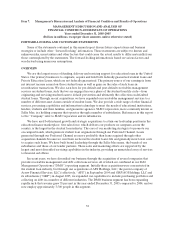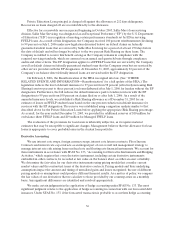Sallie Mae 2005 Annual Report Download - page 36
Download and view the complete annual report
Please find page 36 of the 2005 Sallie Mae annual report below. You can navigate through the pages in the report by either clicking on the pages listed below, or by using the keyword search tool below to find specific information within the annual report.26
In addition, the occurrence of certain events such as consolidations and reconsolidations may cause
the securitization transactions to amortize earlier than scheduled, which could accelerate the need for
additional funding to the extent that we effected the refinancing.
GENERAL
Our business is subject to a number of risks, uncertainties and conditions, some of which are not within our
control, including general economic conditions, increased competition, adverse changes in the laws and
regulations that govern our businesses and failure to successfully identify, consummate and integrate strategic
acquisitions.
Our business is subject to a number of risks, uncertainties and conditions, some of which we cannot
control. For example, if the U.S. economy were to sustain a prolonged economic downturn a number of
our businesses—including our fastest growing businesses, Private Education Loan business and Debt
Management Operations—could be adversely affected. We bear the full risk of loss on our portfolio of
Private Education Loans. A prolonged economic downturn could make it difficult for borrowers to meet
their payment obligations for a variety of reasons, including job loss and underemployment. In addition, a
prolonged economic downturn could extend the amortization period on DMO’s purchased receivables.
We face strong competition in all of our businesses, particularly in our FFELP business. For example,
some FFELP lenders use the federal government’s Direct Lending program as a vehicle to circumvent the
statutory prohibition on refinancing an existing FFELP Consolidation Loan in cases where the borrower is
not eligible to consolidate his loans. The Reauthorization Legislation eliminates this practice effective
July 1, 2006. However, we expect that lenders who employ this practice will substantially increase their
marketing efforts in anticipation of the prohibition of the practice. As a result, we may experience
additional prepayments on our Consolidation Loans through June 30, 2006. There can also be no
assurance that our competitors will not engage in other practices that result in higher than expected
prepayments on our Consolidation Loan portfolio. (See “MANAGEMENT’S DISCUSSION AND
ANALYSIS OF FINANCIAL CONDITION AND RESULTS OF OPERATIONS—LENDING
BUSINESS SEGMENT—Consolidation Loan Activity.”) Such prepayments would adversely impact our
earnings. We are also currently competing with substantial lending partners, including our largest lending
partner, JPMorgan Chase, which accounts for a substantial portion of our FFELP originations and
purchases. Finally, we expect to see more competition in our Private Education Loan business. The strong
margins that we currently maintain in this growing business and that offset some of the margin erosion that
we have experienced in our FFELP business may begin to weaken as more competitors offer competing
products. If these competitive trends intensify, we could face further margin pressure.
Because we earn our revenues from federally insured loans under a federally sponsored loan program,
we are subject to political and regulatory risk. As part of the HEA, the student loan program is periodically
amended and must be “reauthorized” every six years. Past legislative changes included reduced loan yields
paid to lenders (1993 and 1998), increased fees paid by lenders (1993), decreased level of the government
guaranty (1993) and reduced fees to guarantors and collectors, among others. On February 8, 2006, the
President signed the Reauthorization Legislation. The Reauthorization Legislation contains a number of
provisions that over time will reduce our earnings on FFELP student loans, including a requirement that
lenders rebate Floor Income on new loans and a reduction in lender reinsurance. In addition, there can be
no assurances that future reauthorizations and other political developments will not result in changes that
have a materially adverse impact on the Company. (See “MANAGEMENT’S DISCUSSION AND
ANALYSIS OF FINANCIAL CONDITION AND RESULTS OF OPERATIONS—OTHER RELATED
EVENTS AND INFORMATION—Reauthorization.”)
Our principal business is comprised of acquiring, originating, holding and servicing education loans
made and guaranteed under the FFELP program. Most significant aspects of our principal business are
governed by the HEA. We must also meet various requirements of the guaranty agencies, which are
private not-for-profit organizations or state agencies that have entered into federal reinsurance contracts








